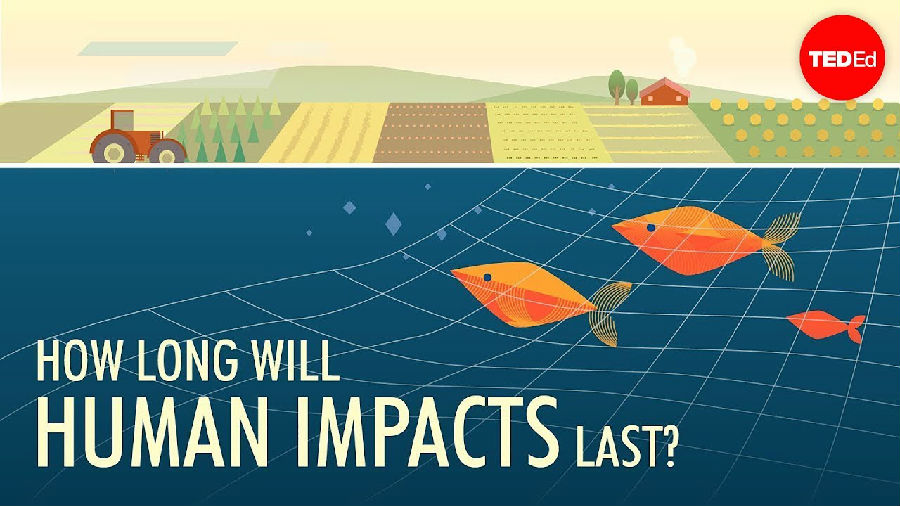(单词翻译:单击)
Imagine aliens land on the planet a million years from now and look into the geologic record.
设想一百万年后外星人登陆地球,并且查看地质记录。
What will these curious searchers find of us?
这些好奇的探索者会找到关于我们的什么信息呢?
They will find what geologists, scientists, and other experts are increasingly calling the Anthropocene, or new age of mankind.
他们会找到“人类世”的痕迹,这个名词被越来越多地质学家、科学家和其他专家使用,意思是属于人类的新世纪。
The impacts that we humans make have become so pervasive, profound, and permanent
人类所产生的影响变得越来越普遍,越来越深入,越来越持久,
that some geologists argue we merit our own epoch.
于是一些地质学家认为应该有一个关于人类的新纪元。
That would be a new unit in the geologic time scale
这个纪元是一个新的地质单元,
that stretches back more than 4.5 billion years, or ever since the Earth took shape.
可以追溯到45亿年前,或者地球形成时。
Modern humans may be on par with the glaciers behind various ice ages or the asteroid that doomed most of the dinosaurs.
现代人类可能就与冰河时代的冰川以及造成恐龙灭绝的小行星并驾齐驱了。
What is an epoch? Most simply, it's a unit of geologic time.
纪元是什么?简单来讲,纪元是地质时间的一个单元。
There's the Pleistocene, an icy epoch that saw the evolution of modern humans.
比如更新世,一个见证了现代人类演进的冰川纪元。
Or there's the Eocene, more than 34 million years ago,
比如3400多万年前的始新世,
a hothouse time during which the continents drifted into their present configuration.
一个地球活跃时间段,在此期间,大陆漂移成了现在的结构。
Changes in climate or fossils found in the rock record help distinguish these epochs and help geologists tell deep time.
气候变化和岩石记录中找到的化石能帮助我们区分这些纪元,帮助地质学家识别更久远的时间。
So what will be the record of modern people's impact on the planet?
现代人类对于地球的影响,会产生怎样的记录呢?
It doesn't rely on the things that may seem most obvious to us today, like sprawling cities.
这并不取决于我们今天所见到的最显眼的东西,例如连绵不绝的城市。
Even New York or Shanghai may prove hard to find buried in the rocks a million years from now.
即便像纽约和上海这样的城市,也可能被埋在一百万年后的岩石下,踪迹难寻。
But humans have put new things into the world that never existed on Earth before, like plutonium and plastics.
但是人类将新东西带到了世界上,这些新东西是地球之前没有的,例如钚和塑料。
In fact, the geologists known as stratigraphers who determine the geologic timescale,
事实上,地质学家中负责测定地质时间的地层学家提出,
have proposed a start date for the Anthropocene around 1950.
“人类世”的开始时间大约在1950年。
That's when people started blowing up nuclear bombs all around the world and scattering novel elements to the winds.
在那时,人们开始在世界范围内投放原子弹,使新元素大量扩散。
Those elements will last in the rock record, even in our bones and teeth for millions of years.
这些元素会留存在岩石记录中,甚至在我们的骨头和牙齿中留存数百万年。

And in just 50 years, we've made enough plastic, at least 8 billion metric tons, to cover the whole world in a thin film.
在仅仅50年中,我们所生产的塑料就达到了80亿公吨以上,足以在地球表面覆盖一个薄层。
People's farming, fishing, and forestry will also show up as a before and after in any such strata
人类的农业、林业、渔业活动也会先后表现在地层中,
because it's those kinds of activities that are causing unique species of plants and animals to die out.
因为是这些活动导致了稀有的动植物物种灭绝。
This die-off started perhaps more than 40,000 years ago as humanity spread out of Africa
这种灭绝情况也许在4万年前人类走出非洲时就开始了,
and reached places like Australia, kicking off the disappearance of big, likable, and edible animals.
我们的祖先到达了像澳大利亚这样的地方,开启了大型、可爱、可食用的动物的消失进程。
This is true of Europe and Asia, think woolly mammoth, as well as North and South America, too.
在欧洲和亚洲是这样的,想一想长毛猛犸象就知道,北美和南美洲的动物也难逃一劫。
For a species that has only roamed the planet for a few hundred thousand years,
对于一个仅仅在地球上出现了几十万年的物种来说,
Homo sapiens has had a big impact on the future fossil record.
智人对于未来的化石记录产生了巨大的影响。
That also means that even if people were to disappear tomorrow, evolution would be driven by our choices to date.
这也意味着,即便人类明天就消失,我们至今为止做出的选择也会推动演进过程。
We're making a new homogenous world of certain favored plants and animals, like corn and rats.
我们正在创造一个同质化的世界,有利于一些特定的动植物,如谷物和老鼠。
But it's a world that's not as resilient as the one it replaces.
但是这个世界不如原来的世界适应能力强。
As the fossil record shows, it's a diversity of plants and animals
化石记录表明,是植物和动物的多样性
that allows unique pairings of flora and fauna to respond to environmental challenges, and even thrive after an apocalypse.
使得特定动植物群有可能去应对环境威胁,甚至在大灾难之后依然繁衍生息。
That goes for people, too. If the microscopic plants of the ocean suffer as a result of too much carbon dioxide, say,
这点对于人类也是一样。假设过多的二氧化碳导致海洋微生植物受损,
we'll lose the source of as much as half of the oxygen we need to breathe.
我们会失去现在一半的氧气来源。
Then there's the smudge in future rocks.
然后是未来岩石中的污迹。
People's penchant for burning coal, oil, and natural gas has spread tiny bits of soot all over the planet.
人类对于燃烧煤、石油、天然气的偏好使细小的煤烟在地球上蔓延。
That smudge corresponds with a meteoric rise in the amount of carbon dioxide in the air,
这种煤烟会导致空气中二氧化碳含量激增,
now beyond 400 parts per million, or higher than any other Homo sapiens has ever breathed.
目前空气中二氧化碳含量已经超过了400ppm,或者说比以前所有智人呼吸过的空气中的二氧化碳含量还要高。
Similar soot can still be found in ancient rocks from volcanic fires of 66 million years ago,
类似的煤烟也能在古岩石中找到,这些岩石来自6600万年前的火山喷发,
a record of the cataclysm touched off by an asteroid at the end of the late Cretaceous epoch.
它记录下了在白垩纪末期由小行星引发的一场大灾难。
So odds are our soot will still be here 66 million years from now, easy enough to find for any aliens who care to look.
因此我们的煤烟也有可能在6600万年后仍然存在,很容易被细心的外星人找到。
Of course, there's an important difference between us and an asteroid.
当然,我们和小行星之间有一个很大的区别。
A space rock has no choice but to follow gravity. We can choose to do differently.
宇宙岩石除了遵循重力规则外别无选择。但是我们可以选择做不一样的事情。
And if we do, there might still be some kind of human civilization thousands or even millions of years from now.
如果我们行动起来,几千年,甚至几百万年后,仍然会有人类文明的存在。
Not a bad record to hope for.
希望这会是一个不错的记录。


